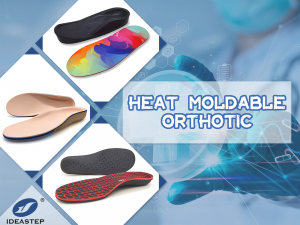
Thermoformed insoles and customized insoles are both types of orthotic inserts used to provide support, comfort, and alignment to the feet. However, there are some differences between the two:
1. Manufacturing Process
Thermoformed insoles are made by heating a pre-fabricated insole material, typically made of EVA (ethylene-vinyl acetate) or similar foam, and then molding it to the shape of the foot using heat and pressure. Customized insoles, on the other hand, are individually designed and fabricated based on a precise impression or scan of the foot, taking into account the specific needs and contours of the wearer’s feet.
2. Level of Customization
Thermoformed insoles offer a certain degree of customization as they can be molded to match the general shape of the foot. However, they do not provide the same level of personalized support as customized insoles, which are specifically designed to address individual foot conditions, such as arch height, pronation (inward rolling) or supination (outward rolling) of the foot, and other biomechanical abnormalities.
3. Prescription and Expertise
Customized insoles are typically prescribed and fabricated by healthcare professionals, such as podiatrists or orthotics, who have expertise in assessing foot conditions and prescribing appropriate orthotic solutions. Thermoformed insoles, on the other hand, are more readily available and can be purchased over the counter without a prescription.
4. Cost
Customized insoles tend to be more expensive than thermoformed insoles due to the additional time, expertise, and materials required for their fabrication. Thermoformed insoles offer a more cost-effective option for individuals who require basic support and cushioning but do not have specific foot conditions or biomechanical abnormalities that require a highly customized solution.
In summary, thermoformed insoles provide a certain level of customization and can offer comfort and support for general foot needs. Customized insoles, on the other hand, provide a higher level of personalization, addressing specific foot conditions and biomechanical issues. The choice between the two depends on the individual’s foot condition, the level of support required, and the budget. It is advisable to consult a healthcare professional to determine the most appropriate option for your specific needs.
Expand more related content:
Thermoformed insoles: https://www.aideastep.com/heatmoldable-orthotic/
Customized insoles: https://www.aideastep.com/custom-orthotic/
